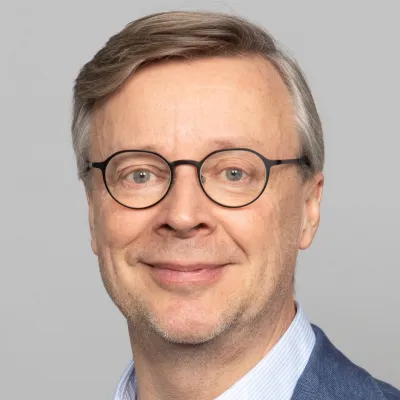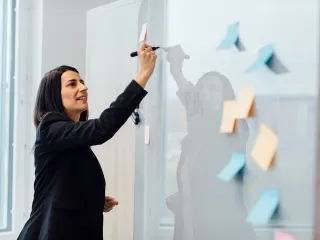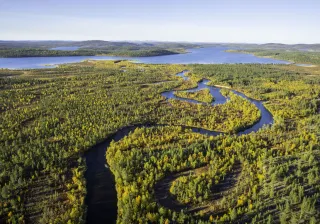Stora Enso and VTT wanted to deepen their existing R&D partnership by bringing together bright minds from both parties. Two successful hackathons produced innovative ideas for future development and helped deepen the collaboration between Stora Enso’s R&D team and VTT’s scientists.
- Inspiring experts to develop and share new ideas
- A new model for collaborating around innovations
- 66 participants in the first Impact Hack
How to think outside the box?
With some 22,000 employees and over 10 billion euros in sales (2021), Stora Enso is a world-leading provider of renewable products in packaging, biomaterials and wooden construction. Stora Enso and VTT have collaborated for many years in research and development projects to create sustainable innovations across the value chain.
While the partnership has been successful, both parties wanted to accelerate the collaboration and try something new.
“We were discussing new ways to bring value to Stora Enso. Something that could be a new way of collaborating in addition to research projects,” Jaakko Kuusisaari, Customer Account Lead at VTT, recalls. “We came up with the idea of bringing together a diverse range of experts from both parties. We wanted to inspire the participants to rise above their day-to-day work and imagine creative solutions to future challenges.”
That’s where the idea to arrange hackathons – a problem-solving method for co-creating new solutions quickly – was born. Hackathons would allow ideas and experts to collide while providing a structure for generating solutions that could ultimately have real business value.
“VTT often has to make educated guesses when they propose new projects for us. Sometimes the proposals are a good match, and sometimes not. With the Impact Hacks, we wanted to test a new mechanism for producing research projects together so that the ideas would be instantly relevant for us,” Jenny Müller-Wahlman, Director of Group Innovation and R&D at Stora Enso, explains.
The plan for Impact Hacks was to not only come up with new ideas but to find new topics and methods for their long-term collaboration. The goal was not to create new intellectual property but to learn from each other and generate ideas worth exploring further. “Unlike traditional hackathons, we weren’t trying to develop new lines of code. We wanted ideas that could have a groundbreaking impact in years to come,” summarises Müller-Wahlman, who led the Impact Hack process at Stora Enso.
We wanted ideas that could have a groundbreaking impact in years to come.

A new approach to creating groundbreaking ideas
There was no template to follow when organising the first Impact Hack. Preliminary discussions indicated that the idea appealed to many, but the outcome was not guaranteed. Would people want to join, and would they be able to innovate in such a short time?
The worries were laid to rest as 66 people participated in the first hackathon. The participants developed their ideas before joining their new team members face-to-face at the hackathon.
Nine teams spent a day together innovating around four topics: nature-inspired solutions, 100% recyclable food packaging, emission-free wood pulp, and future engineered wood joints. The topics were futuristic, inviting participants to tackle unsolved challenges.
“Successful Impact Hacks need colossal challenges or opportunities. Challenges that cannot be solved just like that but require fresh viewpoints and thinking,” Müller-Wahlman clarifies.
After spending a day together, the teams were given two weeks to hone their ideas with the help of mentors. Teams then pitched their ideas and the best ones were eventually picked for further development.
Thanks mainly to the success of the first Impact Hack, VTT and Stora Enso organised a second hackathon six months later. The topic was more focused but still visionary: how could we dramatically reduce the use of process water and improve nutrient capture and usage – in order to solve the circular water challenge?
“In both Impact Hacks, we picked topics that were important on a planetary scale. For example, water availability has not been an immediate concern in the Nordics. Still, to prepare for future challenges, it’s important that we peer far enough into the future and find ways to solve the challenges pre-emptively,” Müller-Wahlman explains.

The ultimate value of Impact Hacks
Assembling a large crowd of individuals from both sides to collaborate on ideas that do not solve immediate business challenges is an investment. But was it worth it?
According to Müller-Wahlman, the speed of innovation was exceptional: “We could not have developed and tested the ideas as quickly as we could without the Impact Hacks. There is still much work left, but we have a promising path for future development and a new, proven method for tackling industry-transforming questions.”
The most significant value may ultimately be newfound partnerships. “The Impact Hacks have catalysed conversation between the two organisations. When scientists with the latest scientific know-how and engineers with profound knowledge of concrete challenges are brought together, conversations and understanding between both parties increase and deepen. There is more trust,” Kuusisaari explains.
The Impact Hacks have catalysed conversation between the two organisations.
“The best part was seeing how people were ready to step beyond their day-to-day work and openly connect and share ideas with people from other organisations. This will hopefully help people pick up the phone and call each other to collaborate on challenges and opportunities beyond the scope of the Impact Hacks,” Müller-Wahlman summarises.
The participants also valued new connections: “It was great to meet people who think so differently. I have my box where I usually work and have identified various things that could be improved but previously didn’t know how to improve them. Meeting people who work with different solutions, trends and technologies widened my horizon and gave me many new ideas on how to develop things,” says Patrik Andersson, a Process Engineer at Stora Enso.
The ideas developed in the Impact Hacks have true business potential. Several ideas were later developed into projects. “Participation alone was valuable, but to me, the most important thing was seeing the ideas ultimately developing into actual research projects,” says Anna Ylinen, Research Scientist at VTT, who took part in the first Impact Hack. “As a researcher, I’m used to studying high-level phenomena and technologies. The Impact Hack was an excellent opportunity to apply basic research to concrete challenges.”
The discussions were fruitful in the short term as well. “We are already looking at a minor installation to improve our water efficiency. We have VTT and the Impact Hack to thank for the idea for that installation,” Andersson praises.
The most important thing was seeing the ideas ultimately developing into actual research projects.
A scientific approach to hackathons
Before, hackathons have mainly been used to connect enterprises with start-ups. With this collaboration, VTT and Stora Enso have shown that the method also works as an innovation tool for launching solutions that may eventually solve global challenges.
“We’ve found a whole new way to collaborate with VTT,” concludes Müller-Wahlman.










